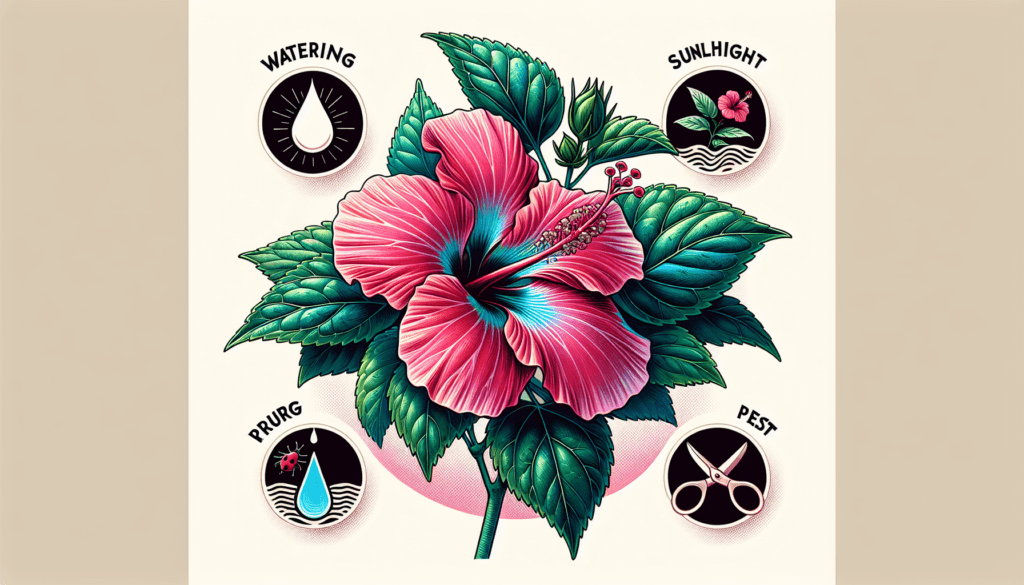Take a moment and imagine a world filled with vibrant, exotic flowers – one of them being the beautiful hibiscus plant. If you’ve ever been captivated by its alluring blooms and want to bring this enchanting plant into your own home, then you’ve come to the right place. In this article, we will explore the ins and outs of hibiscus plant care, providing you with all the knowledge and tips you need to nurture your very own hibiscus plant into a thriving beauty. From watering techniques to sunlight requirements, we’ve got you covered every step of the way. So, get ready to embark on a journey of blooming success as we unravel the secrets of hibiscus plant care together.

Choosing the Right Hibiscus Plant
When it comes to choosing the right hibiscus plant, there are several factors to consider. First and foremost, you need to determine the purpose of the plant. Are you looking for a hibiscus variety that will add a pop of color to your garden? Or are you interested in a specific variety that is known for its medicinal properties? Understanding your specific needs will help you narrow down the options and make a more informed decision.
Once you have determined the purpose of the plant, it’s time to select the ideal hibiscus variety. Hibiscus plants come in a wide range of colors, shapes, and sizes. Some varieties are better suited for landscaping, while others are more suitable for indoor gardening. Consider factors such as the climate you live in, the available space, and your personal preferences when choosing the right variety for your needs.
Another important consideration when choosing a hibiscus plant is the climate and growing conditions. Different varieties of hibiscus thrive in different climates, so it’s essential to select a plant that can withstand the conditions in your area. Consider the average temperature, rainfall, and humidity levels in your region and choose a hibiscus variety that is well-suited to those conditions.
Planting Location and Conditions
Finding the suitable planting spot for your hibiscus plant is crucial for its growth and development. Look for a location that provides adequate sunlight, as hibiscus plants generally require full sun to thrive. Choose a spot where the plant will receive at least 6-8 hours of direct sunlight daily.
In addition to sunlight, proper drainage is essential for hibiscus plants. They prefer well-draining soil and can suffer from root rot if the soil remains too wet. Ensure that the planting spot has good drainage to prevent waterlogged soil and potential damage to the plant’s roots.
Maintaining optimal temperature and humidity is also important for the health of your hibiscus plant. Most varieties prefer temperatures between 60-90°F (15-32°C) and humidity levels around 50-60%. Avoid planting hibiscus in areas prone to extreme temperature fluctuations or high humidity levels, as this can adversely affect their growth.
Preparing the Soil
Choosing the right soil type is crucial for the successful growth of your hibiscus plant. Hibiscus plants thrive in well-draining soil that is rich in organic matter. Look for a soil mix that is specifically formulated for tropical plants or make your own by combining garden soil, compost, and perlite or sand for improved drainage.
To improve drainage and nutrient content, you can incorporate organic matter such as compost or well-rotted manure into the soil. This will help create a loose and fertile soil structure that promotes healthy root development and overall plant growth.
Before planting your hibiscus, it’s essential to test the pH level of the soil. Hibiscus plants prefer a slightly acidic to neutral soil pH range of 6.0-7.0. If the soil is too acidic or alkaline, you can adjust it by adding soil amendments such as sulfur or lime accordingly.

Watering and Irrigation
Determining the watering schedule for your hibiscus plant is important to ensure its health and vitality. While hibiscus plants require regular watering, it’s crucial not to overwater them, as this can lead to root rot and other issues. Water your hibiscus deeply and thoroughly, allowing the top few inches of soil to dry out between waterings. Adjust the frequency of watering based on the weather conditions, as hibiscus may require more water during hot and dry periods.
When it comes to watering techniques, it’s best to water the soil directly rather than the foliage. Watering the leaves can increase the risk of fungal diseases. Use a watering can or a drip irrigation system to ensure even water distribution and prevent waterlogging.
Newly planted hibiscus plants require more frequent watering to help establish their root systems. As the plants mature, you can gradually reduce the frequency of watering. However, always monitor the soil moisture levels and adjust the watering schedule accordingly.
If you are growing hibiscus in containers, proper irrigation is essential. Ensure that the pots have drainage holes and water the plant until you see water flowing out of the drainage holes. This helps prevent water from sitting in the bottom of the container, which can lead to root rot.
Feeding and Fertilization
Understanding the nutritional needs of your hibiscus plants is crucial for their overall health and blooming performance. Hibiscus plants benefit from regular fertilization to ensure they have an adequate supply of nutrients. A balanced fertilizer with a ratio of 10-10-10 or 20-20-20 is generally suitable for hibiscus plants.
When choosing a fertilizer, consider using a slow-release or controlled-release formula. These types of fertilizers release nutrients gradually over time, providing a steady supply of nourishment for the plant. This can be especially beneficial for hibiscus, as they have high nutrient requirements.
When applying fertilizer, always follow the manufacturer’s instructions regarding dosage and frequency. Overfertilizing can lead to nutrient burn and other issues, so it’s important to apply the fertilizer correctly. Distribute the fertilizer evenly around the base of the plant, avoiding direct contact with the stem or foliage.
The frequency and timing of fertilization depend on the specific fertilizer used and the growth stage of your hibiscus plant. Generally, hibiscus plants benefit from monthly fertilization during the active growing season. Reduce or discontinue fertilization during the dormant period, typically in late fall or winter.
In addition to commercial fertilizers, you can also supplement your hibiscus plants with organic matter. This can include compost, worm castings, or well-rotted manure. Organic matter helps improve soil fertility, enhances nutrient retention, and promotes beneficial microbial activity.
Pruning and Trimming
Pruning hibiscus plants is an essential aspect of their care and maintenance. Pruning helps promote healthy growth, maintain the desired shape and size, and rejuvenate the plant. There are several reasons why you may need to prune your hibiscus plants.
One common reason for pruning is to remove dead or diseased branches. Regularly inspect your hibiscus plants and promptly remove any branches that show signs of damage, disease, or pest infestation. Pruning these branches will help prevent the spread of disease and encourage new growth.
When it comes to pruning tools, opt for clean and sharp bypass pruners or loppers. These tools allow for precise cuts without causing unnecessary damage to the plant. Sterilize the blades of your pruning tools before and after each use to prevent the transmission of diseases.
Hibiscus plants can be pruned according to their growth habits. Some varieties grow in a shrub-like manner, while others have a more vine-like growth pattern. Understanding the growth habit of your hibiscus will help you prune it correctly. Prune shrub-like varieties to maintain a compact and bushy shape, and train vine-like varieties to climb or trail as desired.
In addition to shaping and maintaining the overall form of your hibiscus plant, periodic trimming is necessary to prevent it from becoming too large or unruly. Trim back excessive growth to maintain the desired size and shape. This will not only enhance the appearance of your plant but also promote better air circulation and reduce the risk of disease.
Dealing with Pests and Diseases
Like any other plant, hibiscus plants are susceptible to pests and diseases. However, with proper care and preventive measures, you can minimize the risk of infestations and keep your plants healthy.
Common pests that can affect hibiscus plants include aphids, mealybugs, whiteflies, and spider mites. Regularly inspect your plants for signs of pest infestation, such as small insects, sticky residue, or distorted leaves. Implement preventive measures such as keeping the garden clean, removing weeds, and regularly washing the foliage with a gentle spray of water to discourage pests.
If pest infestation occurs, natural remedies can be an effective solution. For example, a mixture of water and mild soap can help control aphids and other soft-bodied pests. Neem oil or insecticidal soap can also be used to eliminate pests. Always follow the instructions on the product label and avoid using chemicals that may harm beneficial insects or pollinators.
Besides pests, hibiscus plants can also be susceptible to various diseases such as fungal leaf spot, powdery mildew, and root rot. Proper cultural practices such as providing adequate airflow, avoiding overhead watering, and maintaining proper plant hygiene can help prevent diseases. If you notice signs of disease, promptly remove affected plant material and treat with appropriate fungicides following the instructions provided.
Support and Staking
Some hibiscus plants, especially the larger varieties or those with a sprawling growth habit, may require support or staking to prevent them from falling over or becoming damaged. Determining the need for support depends on the specific variety and the growing conditions.
When choosing a support structure, consider the height and spread of the plant. Stakes, trellises, or cages can be used to support hibiscus plants and keep them upright. Ensure that the support structure is sturdy and well-anchored to withstand strong winds or heavy foliage.
Methods for staking hibiscus plants vary depending on the growth habit and the desired outcome. For shrub-like varieties, staking can involve tying the branches together to maintain an upright form. Vining or climbing varieties may require trellises or espalier structures to guide their growth and prevent tangling.
Training vines and climbing varieties of hibiscus can be a rewarding experience. As the plant grows, gently guide the branches towards the support structure and secure them in place with soft ties or twine. Regularly check and adjust the ties as needed to ensure proper support and minimize any damage to the plant.
Overwintering and Protection
If you live in an area with cold winters, it’s important to properly prepare your hibiscus plants for the winter season. Hibiscus plants are generally not cold-hardy and can suffer damage or even die if exposed to freezing temperatures for extended periods.
Before winter arrives, prepare your hibiscus plants by gradually reducing watering and fertilizer application. This will help the plants transition into a dormant state. Mulching around the base of the plants with a layer of organic material can also help insulate the roots and protect them from temperature fluctuations.
To protect hibiscus plants from cold temperatures, consider covering them with a frost blanket or burlap. This will provide an additional layer of insulation and help prevent frost damage. In severe winter conditions, you may need to move potted hibiscus plants indoors or to a protected area such as a garage or greenhouse.
If you are growing hibiscus in containers, overwintering becomes easier. You can move the containers to a sheltered location or bring them indoors to protect them from freezing temperatures. Ensure that the plants still receive adequate light and monitor their water needs during the winter months.
Propagation and Reproduction
If you want to expand your hibiscus collection or share plants with friends and family, propagating hibiscus can be a rewarding process. There are several methods of hibiscus propagation, including growing from seeds and taking cuttings.
Growing hibiscus from seeds is relatively straightforward but requires patience. Start by collecting mature seed pods from your existing hibiscus plants. Sow the seeds in a seed-starting mix, keeping them lightly covered. Provide warmth, moisture, and bright light to encourage germination. As the seedlings grow, transplant them into individual pots and care for them as you would any young hibiscus plant.
Taking cuttings is another common method of hibiscus propagation. Select healthy, non-flowering stems and cut them just below a leaf node. Remove any lower leaves and dip the cut end into rooting hormone. Plant the cutting in a well-draining potting mix and keep it moist, but not waterlogged. Place the cutting in a warm and bright location, avoiding direct sunlight. In a few weeks, roots should develop, and the cutting can be transplanted into a larger pot or the garden.
Successful reproduction of hibiscus plants requires attention to detail and proper care. Ensure the right environmental conditions, such as temperature and humidity, and provide adequate light and moisture for the young plants. With patience and care, you can enjoy the satisfaction of growing new hibiscus plants from seeds or cuttings.
In conclusion, choosing the right hibiscus plant involves determining its purpose, selecting the ideal variety, and considering the climate and growing conditions. Creating a suitable planting location, preparing the soil, and ensuring appropriate watering and irrigation practices are important for the plant’s growth and health. Feeding and fertilization, pruning and trimming, dealing with pests and diseases, supporting and staking, overwintering and protection, and propagation and reproduction are key aspects of caring for hibiscus plants. By following these guidelines and providing proper care, you can enjoy vibrant and healthy hibiscus plants that will brighten up your garden or indoor space.

